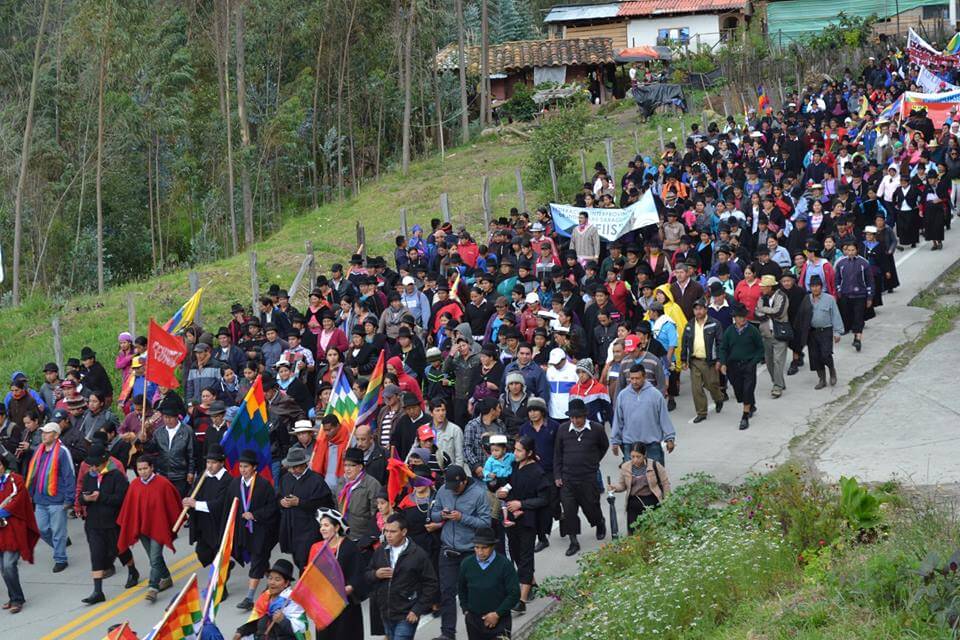
As Andean winds carry mild amounts of ash from the mouth of the Cotopaxi volcano toward the Ecuadorian capital city of Quito, 500 kilometers away, a State of Emergency is in full effect. The government declared the State of Emergency last week purportedly in response to Cotopaxi’s eruption. However, many indigenous protesters, currently mobilized in an ongoing National Strike, believe the government is using the volcano as a pretext to lawfully militarize the streets and impose martial law.
Salvador Quishpe, the Prefect of Zamora and member of the Saraguro Peoples of the country’s southern highlands, took to twitter to point out this very concern, commenting, “They want to scare those of us who are with the national uprising with this emergency decree with respect to Cotopaxi. We won’t fall into their trap.”
Since Aug. 3, Quishpe and Jorge Herrera, the head of the Confederation of Indigenous Nationalities of Ecuador (CONAIE), have led a 500km march that embarked from Zamora, where mining concessions make up 53.7% of the provinces territory. Much of it is indigenous land, including the open-cut “El Mirador” mine that will process 54,000 tonnes of mineralized rock a day in the middle of the rainforest. It was here that the indigenous leader of the Shuar people, José Isidro Tendetza Antún, was tortured and assassinated days before he was due to appear at the Lima Climate Talks in Dec. 2014 to protest the mine’s construction.

Photo: CONAIE
The march then crossed the Andes mountains over the Panamerican Highway–its ranks swelled by the Cañari people, whose civilization pre-dates the Incas, as well as Ecuador’s largest Indigenous populace, the Kichwa. For the past 8 years, they have together been fighting construction of the Quimsacocha mega-mine on pristine Andean wetlands against a backdrop of government persecution; particularly against the Kichwa lawyer and president of Ecuarunari, Carlos Perez Guartambel.
As the march continued towards Quito, contingents from almost all of Ecuador’s Indigenous Peoples joined the uprising from the Shuar and Achuar Peoples of the south-eastern Amazon, historically fierce enemies who united against the shared threat of oil and mining exploitation; to the Kichwa’s of Sarayaku, who accuse oil companies of ethnocide, and were involved in a military confrontation with the Ecuadorian government in 2014. The Indigenous Peoples from the northern lake district of Imbabura, where locals have been battling violent government suppression over the construction of the Intag Copper Mine for over 20 years, also backed the protests.
While each distinct group have demands that coincide with the needs of their respective regions, the official list of demands released by CONAIE includes bringing an end to mining on indigenous lands and repealing the controversial water law. Carlos Perez Guartambel, the president of Ecuarunari, an organization that represents the Kichwa people, told Intercontinental Cry, “The water law that this government approved was not able to remove the privatization of the water; the water is in the hands of multinationals that commercialize bottled water. It’s in the hands of Coca-Cola, Nestle, and Interagua.”
“With the regulation of the water law, the autonomy of community water systems is removed and in some cases promotes privatization,” Perez continued. “This is completely against the constitution which prohibits the privatization [of water].”
Other demands by CONAIE include the right to free university education, the rejection of a free-trade agreement with Europe, stopping the President’s unilateral changes to the constitution, and ensuring the continuation of bilingual education in state-run schools to prevent the extinction of their mother tongues.
“The absorption of everything that represents the institutions of Indigenous Peoples is our main complaint, the primary reason” for the protests, CONAIE’s Director for Women, Katty Betancourt Machoa, told Intercontinental Cry, adding that, “The biggest toll on us is that of bilingual education because [the government] has closed thousands of schools and following the plan of Senplades [Secretaria Nacional de Planificación y Desarrollo] which continues its policy of closing schools–at this moment closing almost 5,000 schools or about 25%, which means another 75% of schools are yet to be closed. This is an outrage for lots of reasons because it’s a form of ethnocide; bilingual schools are centers of cultural generation and community development.”
CONAIE’s Director of Territory, Severino Sharupi, whose role is to defend indigenous territory against external threats, told Intercontinental Cry, “In the last 8 years of this government they have been taking away our rights, rights of the indigenous nationalities and rights of workers, rights of students and retirees, as well as violating the constitution.”
Marlon Santi, the former president of CONAIE, told EFE, “President Correa has to shelve the draft of constitutional amendments submitted to Parliament,” that allow publicly elected officials to run for indefinite re-election, adding that President Correa “cannot remain in power for life, that is not the way, the way of the constitution, democracy.”
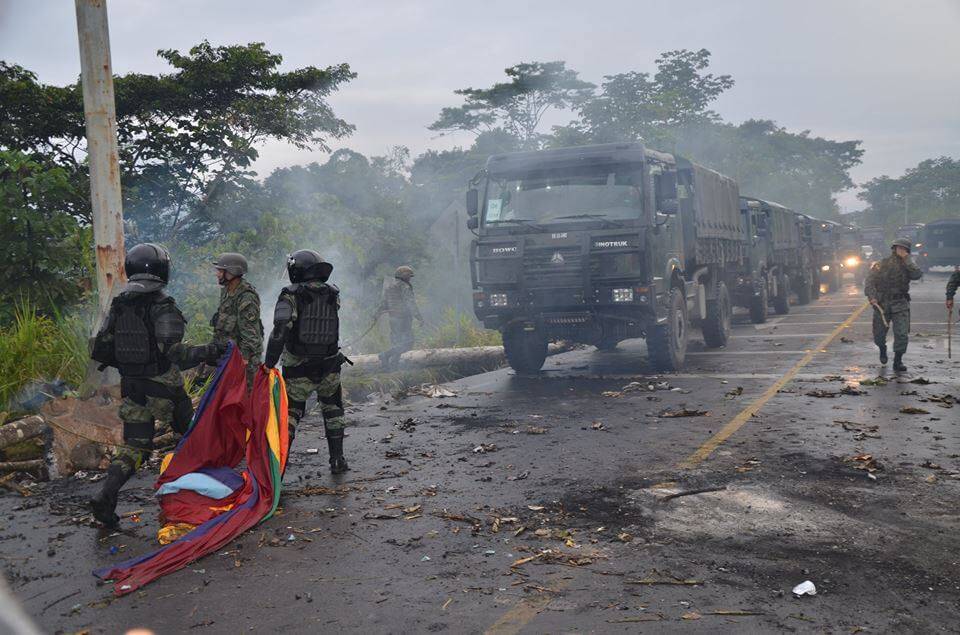
The military holding the indigenous flag (Photo: CONAIE)
On Aug. 13, an estimated 10,000 protesters converged on Quito where they surrounded the Government Palace in the Plaza de Santo Domingo. The protest was peaceful until it was met with overwhelming police force after allegedly being infiltrated by supporters of President Correa. After being released from detention, Salvador Quishpe, speaking to reporters in a ripped shirt that was covered in black dust and dirt, commented that the police “Dragged me, they hit me, they humiliated me.” Just prior to the altercation, he was peacefully beating his drum at the head of the march.
Carlos Perez Guartambel was also beaten and detained by the police along with his partner, Manuela Picq, the French Brazilian journalist for Aljazeera and contributor to Intercontinental Cry. Carlos Perez told Intercontinental Cry, “I am still bruised over my left eye where the police kicked me in the head, hit me with their batons and punched me, and my partner also suffered aggressions and was forced out of the country.”
The beating that Manuela Picq received from the police was severe enough to send her to a hospital for medical treatment. While friends kept vigil in the waiting room, the police arrived to remove her from her hospital bed. At the time, her friends shouted, “They do not have an arrest warrant, this is a kidnap.”
This is not the first time Picq or Perez Guartambel have been targeted for their defense of indigenous rights and the environment; Picq has even written on Intercontinental Cry about the government persecution of her partner. When news spread that the government was attempting to deport the French Brazilian national–who has lived in Ecuador for 8 years–a Change.org petition was published gathering 8,000 signatures, most of it within the 90 hours of her detention.
Manuela Picq is a scholar of international standing on indigenous woman’s issues. Had she not been detained and then forced to leave Ecuador, she would have no doubt written on the violent acts against women by state security forces, which includes indigenous women being, “beaten and violently dragged out of their traditional clothing.”
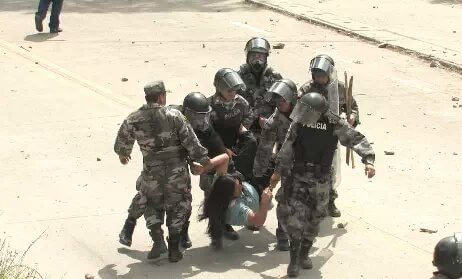
An indigenous woman being carried by seven soldiers (Photo: CONAIE)
“Women of the Strike” proclaimed, “We strongly condemn the macho and criminal brutality with which the State has attacked and criminalized women participating in the demonstrations.”
Three more high profile victims of the government’s violent targeting of women are the caricaturist Vilma Vargas, whose house was broken into in an attempt to intimidate her to stop drawing political cartoons that sympathize with the protesters; the president of CONAIE’s daughter, Liliana Herrera, who lost a tooth after being beaten by police; and the violent incarceration of the feminist and indigenous and environmental rights activist, Margoth Escobar.
“The woman is my mother and she is being unjustly detained at this moment, she is a political prisoner,” Escobar’s son told Intercontinental Cry. “She is a woman of 61 years and was beaten by more than six police. She has scars from this beating over her entire body and she is gravely suffering from hypertension in prison.”
Margoth Escobar has campaigned for indigenous rights in the Ecuadorian Amazon since the late 1980s. Her legacy is widely regarded as having stopped the unilateral colonization of indigenous lands by delineating their ancestral borders and defending them from the threats of colonization, logging, and petroleum exploitation during the 1990s. She is considered a hero among many indigenous Kichwa, Shuar, Achuar and Waorani.
“The abuse of power by this government is immense with regards to my mother. They have beaten her, they have completely violated her rights, there is no guarantee for her life at this moment. The doctors have demanded that she should be hospitalized with at the very least 15 days rest but not even 24 hours passed before the order arrived to remove her from the hospital in a huge police and military operation as if she was a common day criminal.”
“It is outrageous to be in this situation beneath this regime where there is no guarantee of democracy,” the son told Intercontinental Cry, “Today more than ever I request from the people respect for human rights because we all carry the responsibility for what we do in this life. And to you Mr. Rafael Correa, I hold you directly responsible for what is happening to my mother.”
Katty Betancourt explained, “There hasn’t been due process because many of our colleagues that are being detained won’t have their first court date until after a month. How much longer will they be imprisoned?”
After photos of the bruising covering Margoth Escobar’s body and a Youtube video about her legendary accomplishments for indigenous rights went viral she was released from prison, on Aug. 21, a full week after her incarceration. This was the same day that journalist Manuela Picq was forced to leave the country.
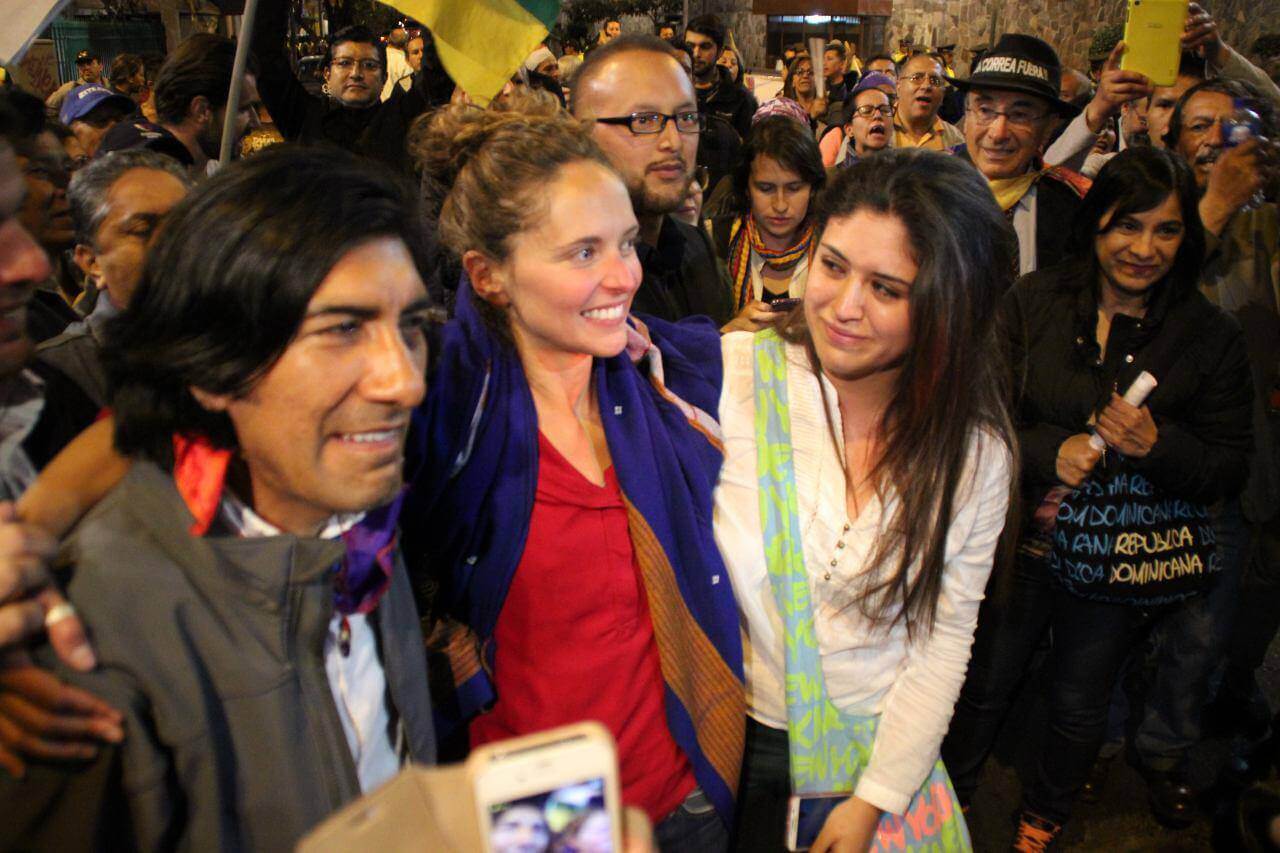
Manuela Picq (center) and Carlos Perez Guartambel (left). (Photo: CONAIE)
The government accused Picq of damaging the country’s patrimonial heritage; but as the journalist left the country for Brazil, she said, “I believe it’s the opposite, my presence in Ecuador has been constructive because valuing the indigenous movement is how we reconstruct the philosophical and cultural patrimony of this country.” She added that, “My relation with the indigenous movement, Carlos and Ecuador are a part of me and I will carry that around for life but hope to return soon.”
One day after the National Strike began, a joint statement from CONAIE and Ecuarunari ratified the “radicalization” of the protests after the government refused to listen to their requests. Jorge Herrera, president of CONAIE, said the protests have been such a success that it should be called the uprising of the Ecuadorian people and not just the indigenous movement, “There are people of all social conditions, small-time business entrepreneurs, retirees, professors, students.”
While the protests consist of Indigenous Peoples of almost every ethnicity, popular support within indigenous populations like the Kichwa is far from universal. “Ecuador is a country of micro-businesses and family companies,” Chasqui Olmedo, a Kichwa whose family run tourism business, Kingdom Kichwa, has been adversely affected by the strikes, told Intercontinental Cry. “We depend on the daily activity of the economy and this is the reason that cows do not understand mobilizations, national strikes, and political protests. Cows will produce milk in the morning and the afternoon but if the highways are closed the milk goes bad. The only people who benefit from these national strikes are the big companies and economic monopolies of the country.”
Olmedo believes CONAIE should sit down with President Correa with a printout of demands to negotiate and resolve the protests. CONAIE’s Director of Territory, Severino Sharupi, told Intercontinental Cry, “We have tried during the eight years of this government to include our approaches and proposals as well as simultaneously for them to also respect our rights won in past uprisings and in the constitution. We tried to talk over the past 8 years and we have some practical examples of this intention to negotiate,” adding that, “Our provincial and regional organizations have signed countless agreements with the government, of which very few have been fulfilled, and have been primarily used to blackmail and condition our people.”

“500 years ago – we came to conquer. Now – we come to negotiate”. Illustration by Vilma Vargas.
CONAIE’s Director for Women, Katty Betancourt, added that, during these protests, “The government has revealed its dictatorial character, its character of centralizing power, and this we can prove through the decree 755, which gives the necessity of creating a State of Emergency on the national level, instead of just in the provinces [surrounding the Cotopaxi Volcano]”.
The government decree puts all of Ecuador’s armed forces and police under the command of two government ministries and permits the suspension of “constitutional rights to the inviolability of home, to movement, to assembly and to correspondence.” After analyzing the points used to justify the State of Emergency decree, human rights lawyer Daniela Salazar said, “There is absolutely no justification for the State of Emergency to be declared in all of [Ecuador’s] national territory.” Reporters Without Borders criticized the government’s decision to censor all news on the Cotopaxi volcano in the Ecuadorian media and over social networks that does not come from official bulletins of the Security Ministry.
A video released by CONAIE shows an indigenous woman screaming as the police and military forces invade her private home, asking. “Why are you in my house?” and “Why did you hit her?” Under this extraordinary decree, such brute force runs the risk of becoming common practice.
On Aug. 19, an assembly of indigenous leaders led by Salvador Quishpe, Carloz Perez Guatembel, and Jorge Herrerra convened to coordinate the next course of action for the strike which has already included the occupation of public buildings.
In the province of Morona Santiago, where the strikes have been strongest, Marlon Vargas, the Director of Communication for the Achuar Nationality, told Intercontinental Cry, “For four days we have been here and now the people are asking what is happening? Why doesn’t the governor come to speak with us? Why doesn’t he come to resolve this problem? We want to speak, we want to know what is happening in our province and in our country so the people met this morning and decided to symbolically take the GAD Provincial building and later the District of Education.”
Morona Santiago governor Rodrigo Lopez, refusing to negotiate with the protesters, decided to send in the army. An estimated 200 Shuar and Achuar people, armed with spears, responded by chasing both the military and police out of the Amazonian city of Macas. While the Shuar and Achuar left the government building peacefully, tensions are still simmering in Morona Santiago.
On Aug. 20, in the province of Tungarahua, where the Andes mountains rise out of the Amazon rainforest, an indigenous community captured a military truck and detained 25 military personnel. The community released those being held when news spread that another 300 members of the military were on their way to the community, foreshadowing a potentially violent confrontation. It was here that the government declared a State of Emergency in 2010, when the Tungarahua volcano erupted; however, in sharp contrast to the recent State of Emergency, none of the constitutional rights of freedom of assembly and the inviolability of home and movement were revoked in 2010 and it only affected areas in proximity to the volcano.
In Ecuador’s north-eastern Amazon, CONAIE reported that protesters paralyzed 28 petroleum wells on the Oso B platform–run by state owned PetroAmazonas–in the Kichwa Zone of Puerto Murialdo, Orellana Province, with 11 protesters being detained. A heavy military presence is being maintained in the area. Elsewhere in the same province, the presence of the Waorani people and their confederation Nawe is noticeably absent. The Waorani, one of the last nationalities to be “contacted” during colonization of the Ecuadorian Amazon, have been severely affected by petroleum drilling on their lands, much like the Indigenous Peoples of Sucumbíos Province during the ecological disaster caused by Chevron Texaco.
According to a book that the Ecuadorian government attempted to censor, A Hidden Tragedy by Miguel Cabodevilla and Milagros Aguierre, the state’s divide and conquer strategies to remove obstacles that hinder its petroleum and mining projects are considered to be one of the causes of the massacre of the uncontacted Taromenane tribe of the Yasuni National Park. The Ecuadorian government also changed the meaning of genocide in its constitution in order to absolve themselves of legal responsibility for the extinction of the uncontacted Taromenane, who some experts believe will be wiped out now that the government has begun drilling into the 7 billion dollar oil reserves inside the Yasuni National Park.
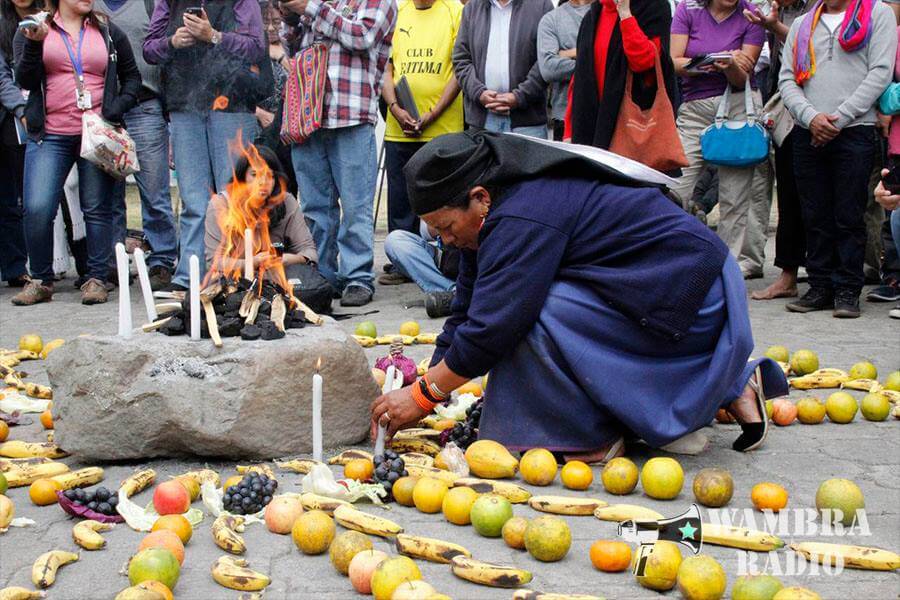
In the Parque del Arbolito in Quito, a woman performs a ceremony for the indigenous who have been detained. (Photo: Wambra Radio)
On Friday, Aug. 21, as CONAIE president Jorge Herrera gave a press conference in Quito’s Park of the Little Tree, he was informed that the Ecuadorian state intends to pursue criminal charges against him as well as Romulo Acacho, the vice president of CONAIE; Franco Viteri, the president of CONFENIAE; and Augustin Guachapá, the president of the Shuar Federation. The group of leaders are being charged with the crime of paralyzing public services under article 346 of the Organic Integrated Penal Code, a charge that carries with it a maximum penalty of three years in prison. “We have not committed any crime,” Herrara said at the press conference.
As of Aug. 24, there are a total of 60 protesters being held in prison and a total of 92 people, including indigenous leaders like Jorge Herrerra, who are being pursued with criminal charges by the judicial system. 44 protesters are being accused of the crime of paralyzing public services and 36 for the crime of attack or resistance.
“The violence generated by the state is progressive and systematic,” Carlos Perez told Intercontinental Cry, adding that a total of 400 people are being persecuted by the state’s judiciary. In addition to the 90 people from the current mobilization, there are another 250 who have been criminalized in protests over the last seven years.
In Salvador Quishpe’s homeland of Saraguro, there are 26 people being held in prison, where reports are emerging of police abandoning protesters in their cells without food for as long as 18 hours. Additionally, there is at least one case of police threatening an indigenous woman under their custody with rape. “This is not fair, we aren’t animals,” said one man as families of the detained protesters gave a video testimony of the conditions inside the prison, adding that those detained are, “suffering from hunger, suffering from the cold, they aren’t even giving them food.”
President Correa’s popularity hangs in the balance, precariously hinging on the hundreds of millions of dollars being invested into social programs and public works around the country. As the price of oil plummets and the money to fund these programs dries up, the President has chosen to mine more instead of spend less. His strategy includes selling a third of its Amazon rainforest to China for mining as well as large sections of the Andean paramos without the permission of its ancestral owners.
Now, instead of gold bars being sailed back to the Spanish Monarch, this modern day conquest of indigenous land is President Correa’s plan to pay back the billions of dollars of debt his government owes the Communist Party of China, in the form of barrels of oil and shipping crates of minerals, irrespective of the consequences to the people, to the environment, and to the basic freedoms and rights enshrined in the Ecuadorian constitution.
Additional reporting by Lidia Velasco, an independent journalist from the Ecuadorian Amazon.

Indigenous Peoples are putting their bodies on the line and it's our responsibility to make sure you know why. That takes time, expertise and resources - and we're up against a constant tide of misinformation and distorted coverage. By supporting IC you're empowering the kind of journalism we need, at the moment we need it most.